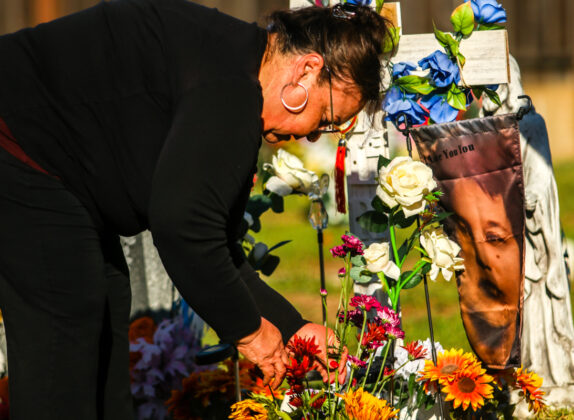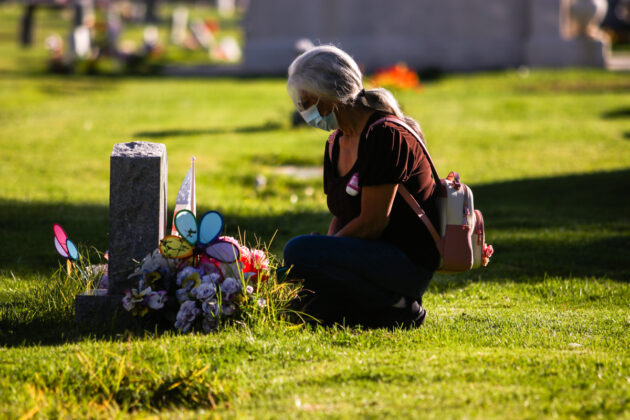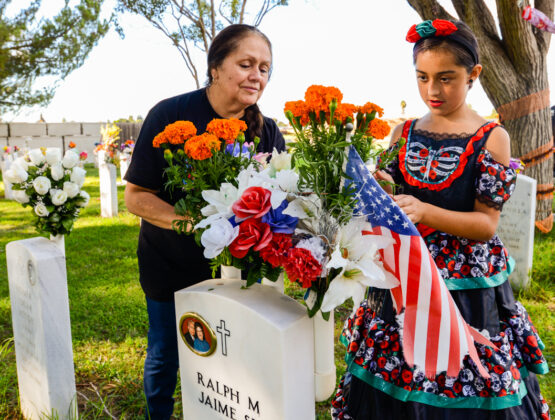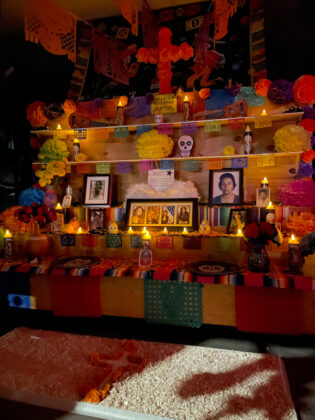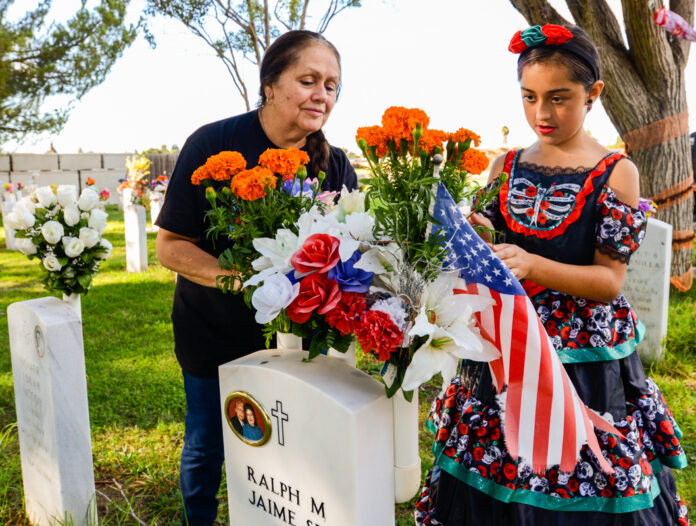
Día de los Muertos (Day of the Dead) is a joyous remembrance of the lives of family members and loved ones who have passed away. It’s also a time to celebrate the cycle of life.
On Tuesday, Helen Bustos of Hollister stopped by Calvary Cemetery on Hillcrest Road to visit her parents, Ralph M. Sr. and Ruby Lupe Jaime, who were laid to rest at the cemetery.
Bustos brought along her granddaughter, Tiger Lilly, who was dressed in a black traditional folklorico style dress decorated with skulls and a section that displays the upper part of a rib cage.
Ralph, who was a US Army Sergeant and a World War II veteran, and his wife, Ruby, are buried alongside other military veterans.
The Bustos’ brought a bouquet of bright orange marigold flowers that were placed on the raised headstone. Like many families at the cemetery, they spent some time with the dearly departed.
Other families and friends set up makeshift picnics and altars right next to the gravesite of their loved ones.
The holiday is celebrated throughout Latin America on Nov. 1 and 2 but it is more closely associated with central Mexico, where it originated.
According to History.com, Day of the Dead or Día de Muertos is an ever-evolving holiday that traces its earliest roots to the Aztec people in what is now central Mexico.
The Aztecs used skulls to honor the dead a millennium before the Day of the Dead celebrations emerged, according to the website. Skulls, such as the ones once placed on Aztec temples, remain a key symbol in a tradition that has continued for more than six centuries in the annual celebration to honor and commune with those who have passed on.
Once the Spanish conquered the Aztec empire in the 16th century, the Catholic Church moved indigenous celebrations and rituals honoring the dead throughout the year to the Catholic dates commemorating All Saints Day and All Souls Day on Nov. 1 and 2.
In Mexico, the old tale says that the souls of the dead return to visit the living for a few brief hours during the celebrations. The cemeteries are cleaned and decorated with traditional marigold flowers along with special food or candies.
The home altars are designed with ofrendas (offerings) to the dead such as some of the things they enjoyed most in life, including food, drink and music.
Delia Del Real Gutierrez of Hollister set up an altar at the cemetery for her mom, Angelita Bueno Del Real, who died on July 27. She was 94 years old.
Del Real Gutierrez said her mom worked for 37 years at Hollister Canning Company before it changed to San Benito Foods. She recalled when Angelita would run during her break time from the cannery on East Street to their house on Victoria Avenue to make sure all 12 kids were in good hands.
“She’d leave us sandwiches or burritos,” Del Real Gutierrez said. “She would tell us ‘Don’t turn on the stove, don’t open the door for nobody.’”
Del Real Gutierrez said her mom persevered a lot, with the pandemic being only the latest hardship.
“Believe me, she was more on her way to heaven than anywhere,” Del Real Gutierrez said. “Mom was spoiled. She was probably one of the few that ate at every restaurant.”
San Benito County League of United Latin American Council 2890 and Youth Council 705 put together its 1st annual Dia de los Muertos (Day of the Dead) celebration and Remembrance Altar.
LULAC issued a press release saying that the altar was built inside the Artesanias Alcala store at 55 San Benito St. in Hollister. Community members brought ofrendas to the altar starting on Oct. 22
The LULAC Youth Community Ofrenda can be seen until Nov. 3.
LULAC said in the statement that San Benito County has lost many family members due to the Covid-19 pandemic. They hope that families had the opportunity to display a photo, a flower or a candy that they enjoyed.
“Dia de los Muertos provides people with the opportunity to rejoice in the living memories of their loved ones,” LULAC Youth Advisor Vince Luna said. “It is important to our Latino community because it is a way to celebrate our culture and the celebration teaches people around the world about our traditions.”



